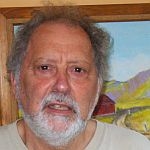 (Host) What will the New Year hold for farming, food and forestry in the Green
(Host) What will the New Year hold for farming, food and forestry in the Green
Mountain state? Commentator Ron Krupp looks at the challenges and opportunities we
face with our working landscape.
(Krupp) A couple of years ago, I traveled to Eastport, Maine – the easternmost city
in the United States. I went to visit Paul Weston, an old friend. Eastport lies
on the Bay of Fundy – right on the Atlantic Ocean and the border with Canada. We
went sailing and saw minke whales, porpoises, eagles, seals and barges of wood
pulp being sent to China for making paper. Closer to home, Margaret Daniel,
another friend who lives on Christian Hill in Bethel – took me on a walk over to
the white granite quarry you can see from Interstate 89. These days that rare
type of granite is also sent to China.
In Vermont, the loss of family dairy farms is paralleled by the closure of
saw mills and the decline of forest-based enterprises. Ninety percent of
our fluid milk is sent out of state to be bottled or made into cheese, yogurt
and other dairy products. Sixty percent of our timber is exported to be
processed. In the last sixty years, the global economy has had a dramatic
impact on the viability of the industries that comprise Vermont’s farm and
forest economy. These industries must compete with lower cost production
elsewhere and with subsidies that make for an uneven playing field.
The Green Mountain State faces a fundamental contradiction. While the
public desires a strong working landscape, we’ve never had a strategic plan to
address and promote investments in this part of our future, until now. One
exception is the Farm to Plate Initiative which passed the legislature two years
ago. The Vermont Council on Rural Development recently created the Working
Landscape Council made up of farmers, foresters, planners and public officials.
They are developing an action plan to address these concerns and come up with
solutions.
The plan will go before the legislature this coming session.
The good news is that Vermont has healthy soils and a receptive climate.
There is an increased demand for locally sourced, sustainably produced farm and
forest products. Visitors are strong supporters of the working landscape. There
is an opportunity to build on the popularity of the Vermont Brand and the fact
that there is a market of 65 million people within a day’s drive. We need to
invest in the future of farms and forests through diversification and the
development of value-added products.
The economic enterprises that built and sustained our working landscape
have been essential in forming the state’s character, its communities and
culture. Vermont Senator Dick McCormack says it well in his musical chorale
called Forbearers. The land is of my forbearers – who conformed its wildness to
their own design, who plowed measured furrows across he random swells and
designed its boundaries in rows of stone, who baptized it with their own sweat
and their blood and joined it with their bones.